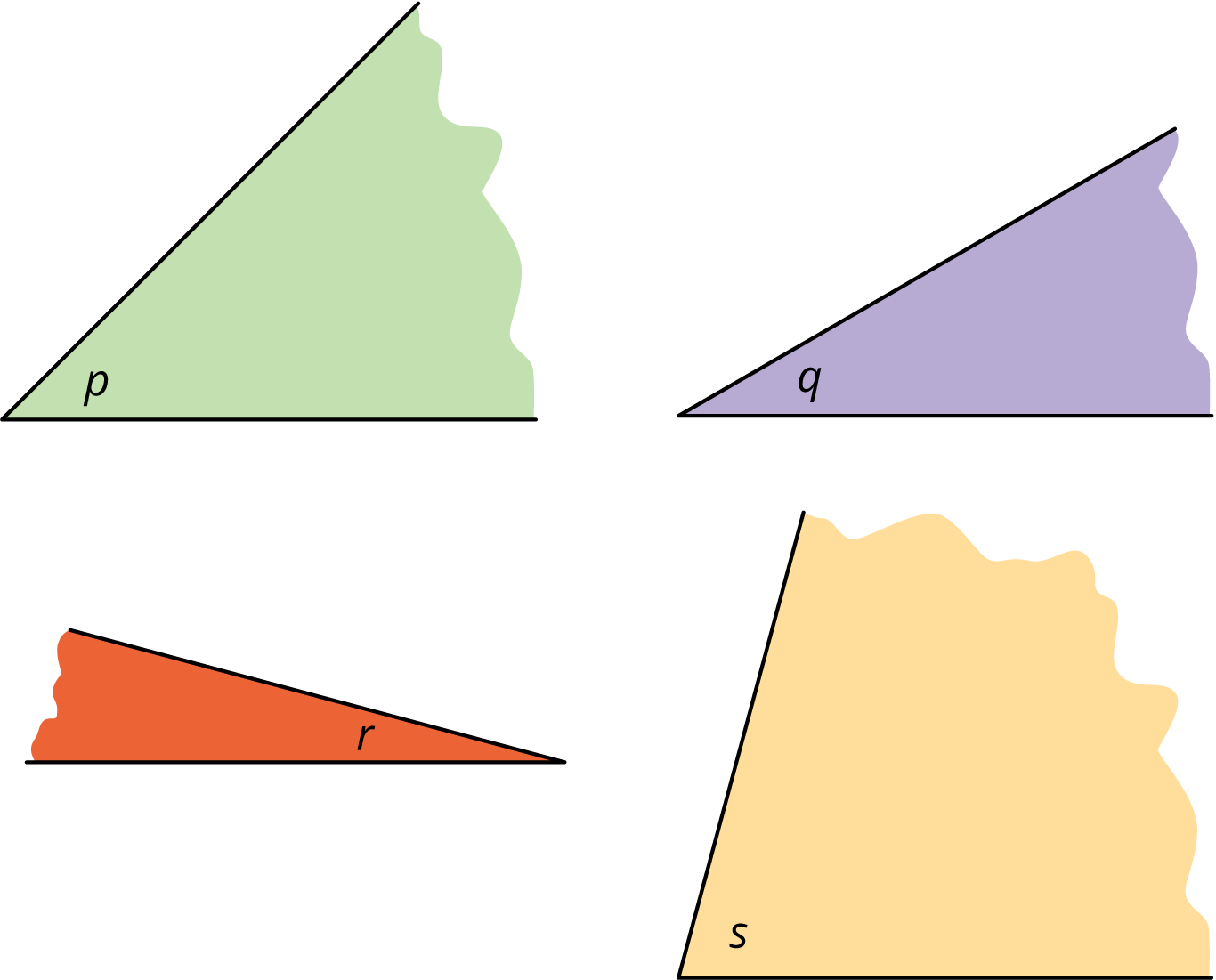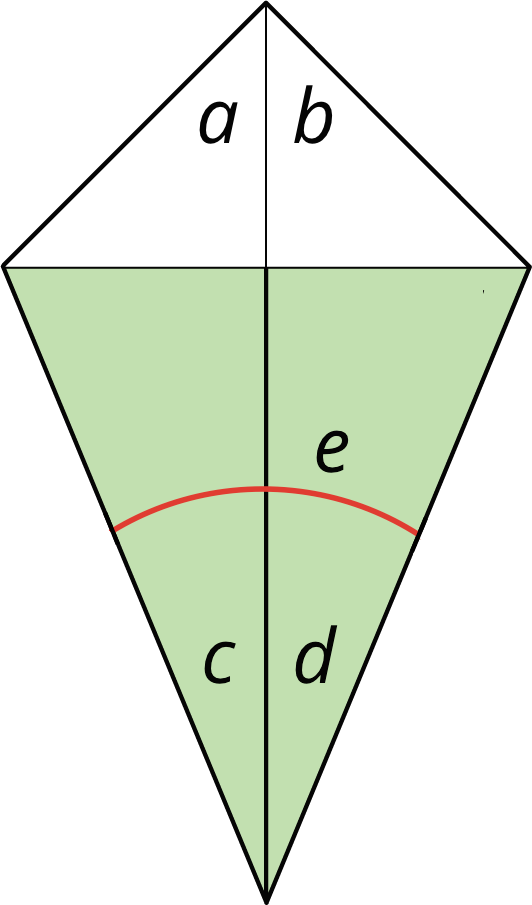Lesson 13
Find Angle Measurements
Warm-up: Notice and Wonder: Corner Pieces (10 minutes)
Narrative
This warm-up prompts students to visualize the idea of arranging angles around a point and adding their measurements as more pieces are added. The angles are familiar angles: \(90^\circ\), \(180^\circ\), and \(270^\circ\). Students previously arrived at these benchmarks by decomposing a full turn or \(360^\circ\). Here, they compose a full turn from \(90^\circ\) angles.
The work here familiarizes students with the context and mathematics that might be involved later in the lesson. In the subsequent activities, students will compose and decompose paper cutouts of angles to determine angle measurements.
Launch
- Groups of 2
- Display the image.
- “What do you notice? What do you wonder?”
- 1 minute: quiet think time
Activity
- “Discuss your thinking with your partner.”
- 1 minute: partner discussion
- Share and record responses.
Student Facing
What do you notice? What do you wonder?

Student Response
For access, consult one of our IM Certified Partners.
Activity Synthesis
- “What angles do you think are the measurement of each angle?” (They look like \(90^\circ\), \(180^\circ\), and \(270^\circ\) angles.)
- “How do you know?” (If the paper is a rectangle, then the corner pieces are right angles or \(90^\circ\) each. Two of the corner pieces would be \(90+90\). Three pieces would be \(90+ 90+90\).)
- “What angle would we get if we add the last corner piece?” (\(360^\circ\))
Activity 1: How Big Are These Angles? (25 minutes)
Narrative
In this activity, students use their knowledge of \(90^\circ\), \(180^\circ\), and \(360^\circ\) and paper cutouts of some acute angles to determine the measurements of those angles. They then use those measurements to compose and find the measurements of larger angles.
No explicit directions for finding the angles are given, so students have an opportunity make sense of the problem and use what they know about the additivity of angles to find the angle measures (MP7). If requested, give students access to rectangular sheets of paper whose square corners could be torn off.
This activity uses MLR5 Co-Craft Questions. Advances: Reading, Writing.
Required Materials
Required Preparation
- Create 4 copies of each angle (\(p\), \(q\), \(r\), and \(s\)) from the blackline master for each group of 2–4 students.
- Cut out the angles in advance, or prepare scissors and extra time for students to cut out the angles.
- If using patty paper instead of cutouts of the angles, each student needs 1–2 sheets of patty paper.
Launch
- Groups of 2–4
- Give each group the cutouts of the four angles, 4 copies of each angle per group, or if using patty paper, give 1–2 sheets to each student.
- If using patty paper, demonstrate that it can be used for tracing the angles.
Activity
- Display only the image to the first problem without revealing the question.
- “Write a list of mathematical questions that could be asked about this image.” (What is the size of each of the angles? Could we put angles together to make right angles? Would all of the angles make a straight line? Which angle is closest to 90 degrees and how far away from 90 degrees is it?)
- 2 minutes: independent work time
- 2–3 minutes: partner discussion
- Invite several students to share one question with the class. Record responses.
- “How are these questions alike? How are they different?” (Most questions are related to the size of the angles.)
- Reveal the task (students open books), and invite additional connections.
- Monitor for groups who:
- compose 2 copies of angle \(p\) or 3 copies of angle \(q\) into a right angle
- compose 2 copies of angle \(r\) into \(q\)
- compose angles \(p\) and \(q\) into angle \(s\)
- Pause for a whole-class discussion. Select students or groups who reasoned as previously outlined to share their reasoning.
- 3–4 minutes: independent work time on the second question
- 2 minutes: group discussion
- Monitor for the different ways that smaller angles are used to compose the angles in parts a–d.
Student Facing
Your teacher will give you materials that can help you find angle measurements.
- Use the materials and what you know about a right angle to find the size of angles \(p\), \(q\), \(r\), and \(s\). Be prepared to explain or show your reasoning.

-
Next, use the measurements of angles \(p\), \(q\), \(r\), and \(s\) to find the measurements of the following angles.
Student Response
For access, consult one of our IM Certified Partners.
Advancing Student Thinking
Activity Synthesis
- Invite students to share their responses and reasoning for the second question. Display the angles.
- For each angle in parts a–d, record the different compositions of angles students use to find its measurement. For example:
- To compose the angle in part a, students may use angles \(p\), \(r\), and \(s\), or they may use 3 copies of \(p\).
- To find the angle in part c, students may use 3 copies of angle \(s\), or they may draw a line to separate \(180^\circ\) of the angle and fit angle \(p\) in the remaining space.
Activity 2: Angles in a Kite (10 minutes)
Narrative
In this activity, students find the size of angles created by folding paper several times and reasoning about the resulting angles (MP7).
The first fold decomposes the paper into two congruent shapes whose edges line up exactly, and students could see how the folding split two of the angles into equal halves. The subsequent folds decompose an angle into two equal angles, but this may not be obvious to students because the shapes of the two resulting parts are different. (The edges or creases that form the angles are of different lengths.) Students need to remember that angles are not determined by the length of the segments that form it and reason accordingly.
Some students may need support in folding paper precisely. Consider providing a larger sheet of paper or a straightedge to facilitate the folding.
Supports accessibility for: Conceptual Processing, Visual-Spatial Processing
Required Materials
Materials to Gather
Launch
- Groups of 2–4
- Give each student a sheet of origami paper or square paper.
- Display the paper folding diagrams.
Activity
- 2–3 minutes: independent work time
- 2–3 minutes: group discussion
- Monitor for students who recognize that two angles are equal if the edges or creases that form them line up exactly (even if one crease or edge is longer than the other).
Student Facing
Your teacher will give you a square sheet of paper. Follow the steps to fold the paper into a kite. Fold as precisely as possible.


Student Response
For access, consult one of our IM Certified Partners.
Advancing Student Thinking
Activity Synthesis
- Invite students to share their responses and reasoning.
- “How can we tell if the first fold resulted in pairs of equal-size angles?” (The two triangles are identical and match up exactly, which means the angles in the two halves are the same.)
- “The shapes that result from the second and third folds are not the same. Do those folds produce equal-size angles as well?” (Yes. The edges of the resulting angles match up exactly and meet at the same endpoint, so the angles are the same size.)
- “Which angle is larger, \(b\) or \(e\)?” (They are the same, both are \(45^\circ\). Angle \(b\) is half of 90. Angle \(e\) is twice \(22.5^\circ\).)
Lesson Synthesis
Lesson Synthesis
“Today we used different operations to find the measurement of different angles.”
Display:


“Here are some angles whose measurements we tried to find: angle \(p\), angle \(s\), and some angles composed of smaller angles. We used different operations to find the unknown measurements.”
“Which of these angles can we find by using division?” (Angle \(p\): If we know that 2 copies of \(p\) make a right angle, which is \(90^\circ\), then dividing \(90^\circ\) by 2 gives us the measure of \(p\).)
“Which unknown angle can we find by multiplication?” (The angle made up of four \(30^\circ\) angles has a measurement of \(4 \times 30\).)
“Which unknown angle can we find by subtracting one angle from another?” (Angle \(s\): We can subtract \(30^\circ\) from \(180^\circ\) and divide by 2 to find the measure of \(s\), which is \(75^\circ\).)
“Which unknown angle can we find by adding known angles?” (Once we know the measure of angle \(s\), we can find the last angle: \(15 + 75 + 15\), which is \(105^\circ\).)
Cool-down: Sets of Three Angles (5 minutes)
Cool-Down
For access, consult one of our IM Certified Partners.
